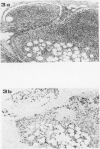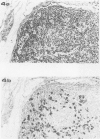Abstract
Immunological markers improve specificity and accuracy of cell detection, therefore it is important to evaluate their usefulness in improving standard histological procedures. This study investigates whether immunocytochemical techniques increase the accuracy of detection, in axillary lymph nodes, of metastatic cells from infiltrating breast lobular carcinoma (ILC). Fifty cases of ILC reported to be node-negative were selected. New serial sections were cut from a total of 767 lymph nodes, stained with H&E and tested in immunoperoxidase (ABC procedure) with a conventional anti-Epithelial Membrane Antigen (EMA) serum, with a monoclonal raised against human milk fat globule membranes (HMFG-2) and with a monoclonal against 54 kd keratin. Metastases were detected immunocytochemically in 12 cases (24%); in five of these cases metastatic cells were also visible in serial H&E sections. Monoclonals offered no evident advantage over anti-EMA conventional antiserum. Immunocytochemical positivity alone is not sufficient evidence for metastatic invasion since macrophages occasionally appear EMA- and HMFG-2-positive (probably because of secondary incorporation of the antigen), and so an improvement in the accuracy of breast cancer metastatic cell detection in axillary lymph nodes requires a combined histo-immunological approach.
Full text
PDF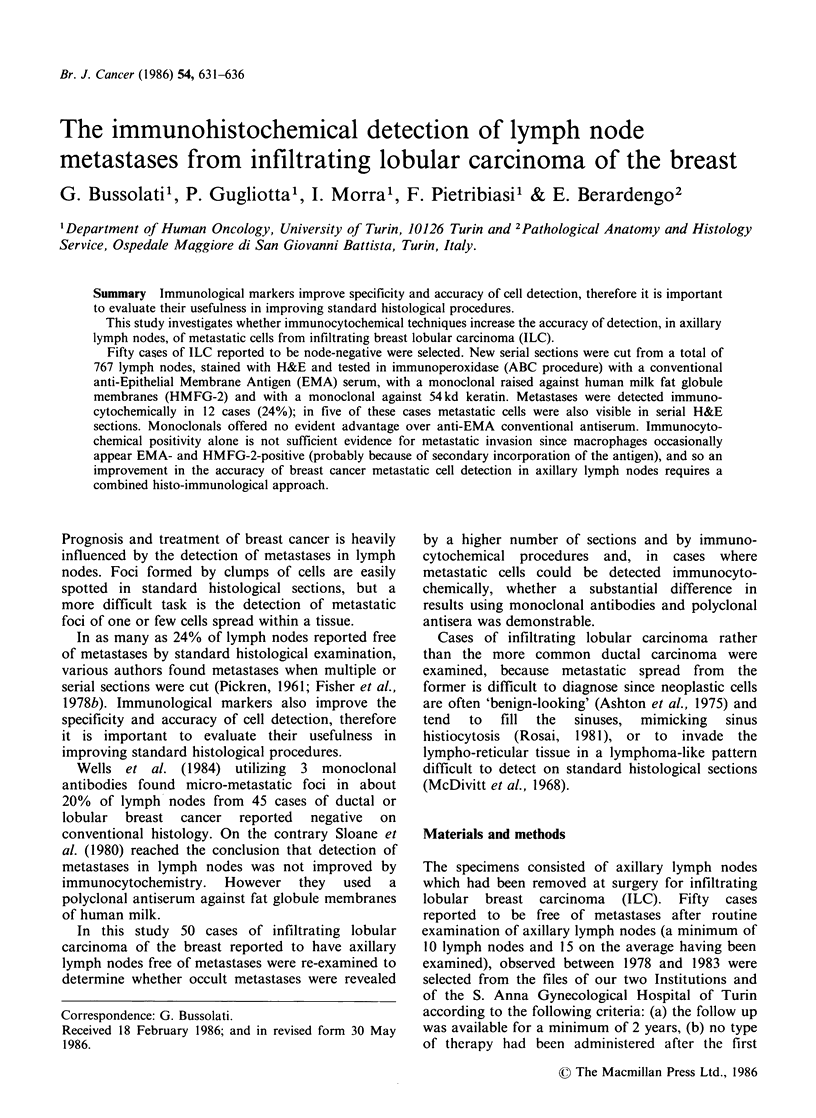
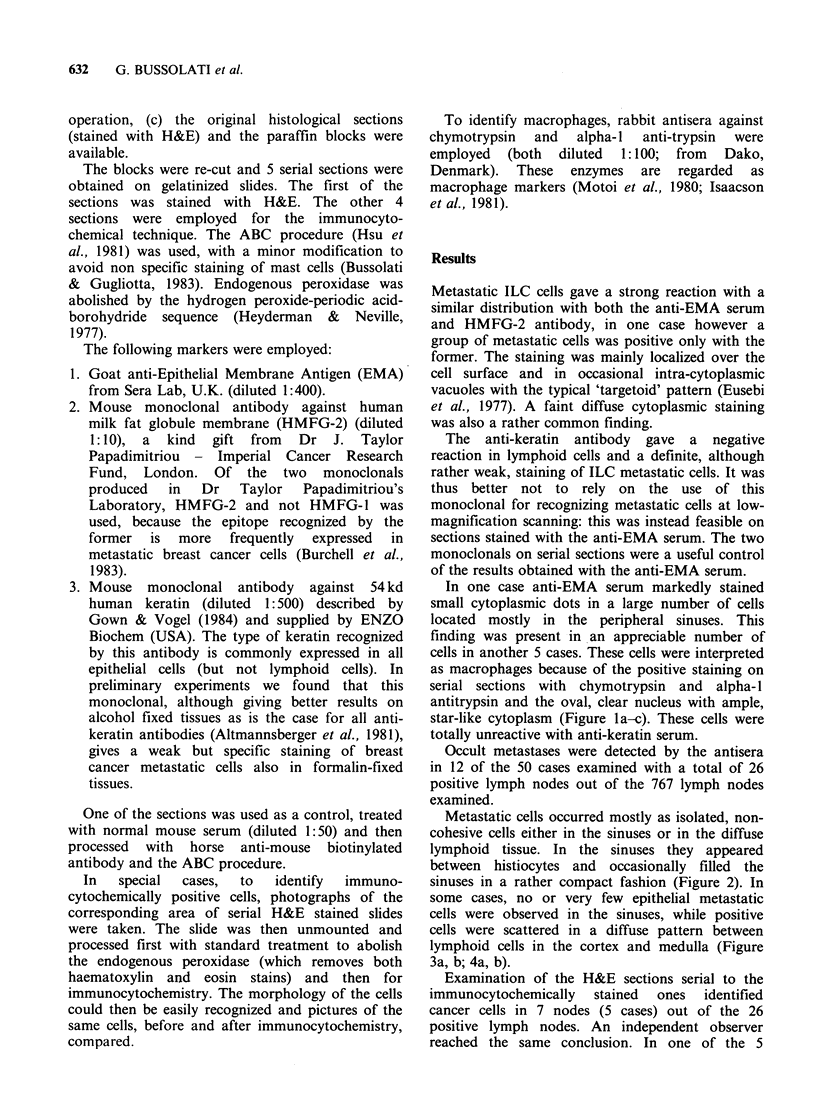
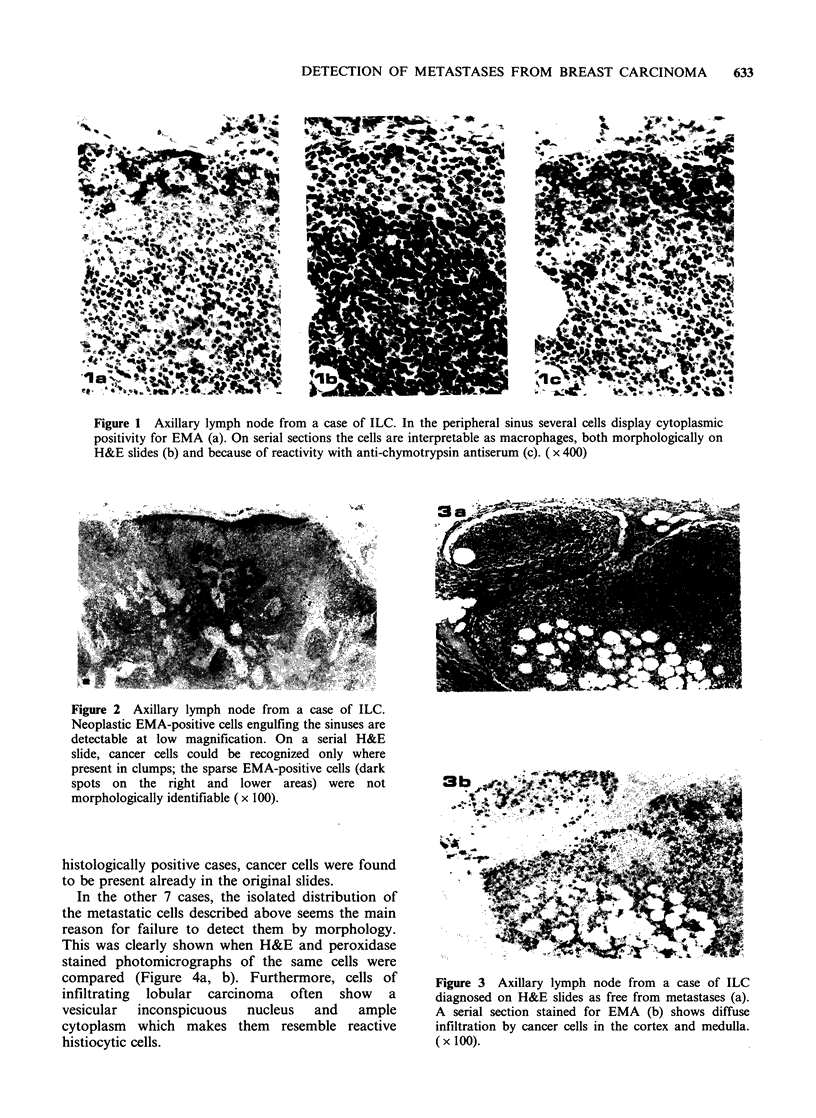


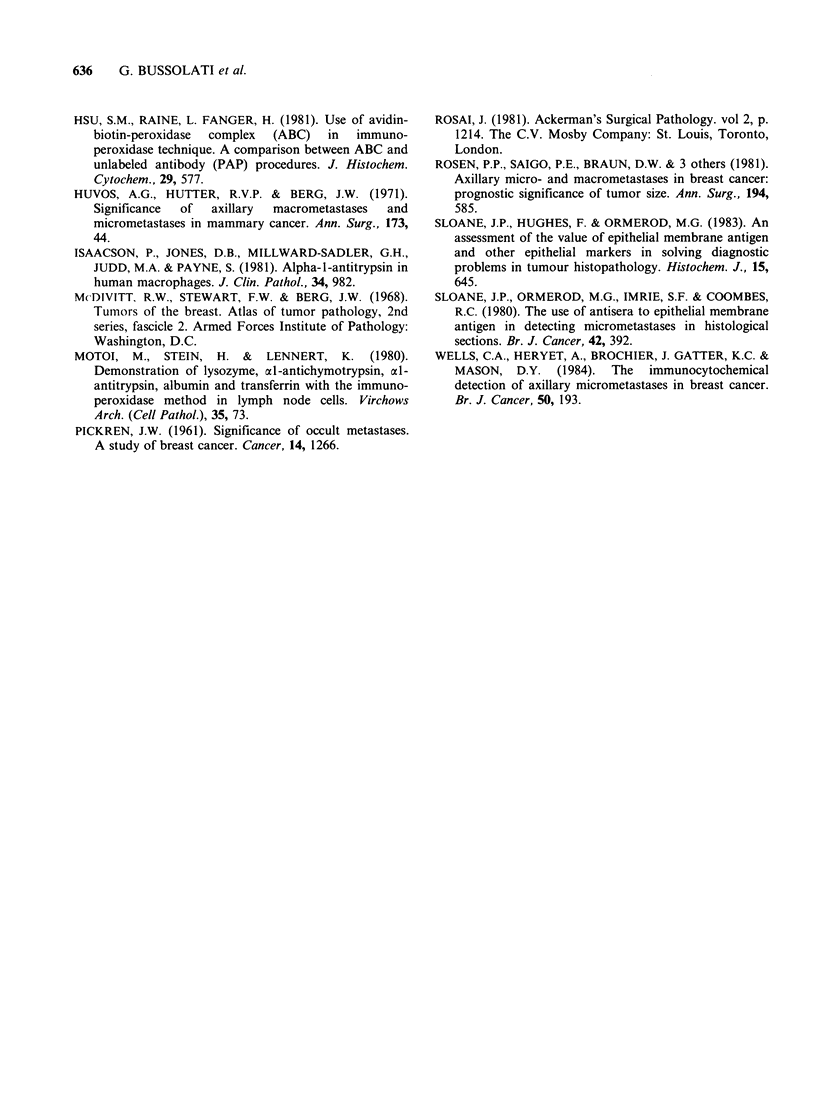
Images in this article
Selected References
These references are in PubMed. This may not be the complete list of references from this article.
- Altmannsberger M., Osborn M., Hölscher A., Schauer A., Weber K. The distribution of keratin type intermediate filaments in human breast cancer. An immunohistological study. Virchows Arch B Cell Pathol Incl Mol Pathol. 1981;37(3):277–284. doi: 10.1007/BF02892576. [DOI] [PubMed] [Google Scholar]
- Ashton P. R., Hollingsworth A. S., Jr, Johnston W. W. The cytopathology of metastatic breast cancer. Acta Cytol. 1975 Jan-Feb;19(1):1–6. [PubMed] [Google Scholar]
- Attiyeh F. F., Jensen M., Huvos A. G., Fracchia A. Axillary micrometastasis and macrometastasis in carcinoma of the breast. Surg Gynecol Obstet. 1977 Jun;144(6):839–842. [PubMed] [Google Scholar]
- Burchell J., Durbin H., Taylor-Papadimitriou J. Complexity of expression of antigenic determinants, recognized by monoclonal antibodies HMFG-1 and HMFG-2, in normal and malignant human mammary epithelial cells. J Immunol. 1983 Jul;131(1):508–513. [PubMed] [Google Scholar]
- Bussolati G., Gugliotta P. Nonspecific staining of mast cells by avidin-biotin-peroxidase complexes (ABC). J Histochem Cytochem. 1983 Dec;31(12):1419–1421. doi: 10.1177/31.12.6195216. [DOI] [PubMed] [Google Scholar]
- Delsol G., Gatter K. C., Stein H., Erber W. N., Pulford K. A., Zinne K., Mason D. Y. Human lymphoid cells express epithelial membrane antigen. Implications for diagnosis of human neoplasms. Lancet. 1984 Nov 17;2(8412):1124–1129. doi: 10.1016/s0140-6736(84)91558-7. [DOI] [PubMed] [Google Scholar]
- Eusebi V., Pich A., Macchiorlatti E., Bussolati G. Morpho-functional differentiation in lobular carcinoma of the breast. Histopathology. 1977 Jul;1(4):301–314. doi: 10.1111/j.1365-2559.1977.tb01668.x. [DOI] [PubMed] [Google Scholar]
- Fisher E. R., Palekar A., Rockette H., Redmond C., Fisher B. Pathologic findings from the National Surgical Adjuvant Breast Project (Protocol No. 4). V. Significance of axillary nodal micro- and macrometastases. Cancer. 1978 Oct;42(4):2032–2038. doi: 10.1002/1097-0142(197810)42:4<2032::aid-cncr2820420453>3.0.co;2-o. [DOI] [PubMed] [Google Scholar]
- Fisher E. R., Swamidoss S., Lee C. H., Rockette H., Redmond C., Fisher B. Detection and significance of occult axillary node metastases in patients with invasive breast cancer. Cancer. 1978 Oct;42(4):2025–2031. doi: 10.1002/1097-0142(197810)42:4<2025::aid-cncr2820420452>3.0.co;2-j. [DOI] [PubMed] [Google Scholar]
- Gown A. M., Vogel A. M. Monoclonal antibodies to human intermediate filament proteins. II. Distribution of filament proteins in normal human tissues. Am J Pathol. 1984 Feb;114(2):309–321. [PMC free article] [PubMed] [Google Scholar]
- Heyderman E., Graham R. M., Chapman D. V., Richardson T. C., McKee P. H. Epithelial markers in primary skin cancer: an immunoperoxidase study of the distribution of epithelial membrane antigen (EMA) and carcinoembryonic antigen (CEA) in 65 primary skin carcinomas. Histopathology. 1984 May;8(3):423–434. doi: 10.1111/j.1365-2559.1984.tb02354.x. [DOI] [PubMed] [Google Scholar]
- Heyderman E., Neville A. M. A shorter immunoperoxidase technique for the demonstration of carcinoembryonic antigen and other cell products. J Clin Pathol. 1977 Feb;30(2):138–140. doi: 10.1136/jcp.30.2.138. [DOI] [PMC free article] [PubMed] [Google Scholar]
- Hsu S. M., Raine L., Fanger H. Use of avidin-biotin-peroxidase complex (ABC) in immunoperoxidase techniques: a comparison between ABC and unlabeled antibody (PAP) procedures. J Histochem Cytochem. 1981 Apr;29(4):577–580. doi: 10.1177/29.4.6166661. [DOI] [PubMed] [Google Scholar]
- Huvos A. G., Hutter R. V., Berg J. W. Significance of axillary macrometastases and micrometastases in mammary cancer. Ann Surg. 1971 Jan;173(1):44–46. doi: 10.1097/00000658-197101000-00006. [DOI] [PMC free article] [PubMed] [Google Scholar]
- Isaacson P., Jones D. B., Millward-Sadler G. H., Judd M. A., Payne S. Alpha-1-antitrypsin in human macrophages. J Clin Pathol. 1981 Sep;34(9):982–990. doi: 10.1136/jcp.34.9.982. [DOI] [PMC free article] [PubMed] [Google Scholar]
- PICKREN J. W. Significance of occult metastases. A study of breast cancer. Cancer. 1961 Nov-Dec;14:1266–1271. doi: 10.1002/1097-0142(196111/12)14:6<1266::aid-cncr2820140617>3.0.co;2-9. [DOI] [PubMed] [Google Scholar]
- Rosen P. P., Saigo P. E., Braun D. W., Weathers E., Fracchia A. A., Kinne D. W. Axillary micro- and macrometastases in breast cancer: prognostic significance of tumor size. Ann Surg. 1981 Nov;194(5):585–591. doi: 10.1097/00000658-198111000-00006. [DOI] [PMC free article] [PubMed] [Google Scholar]
- Sloane J. P., Hughes F., Ormerod M. G. An assessment of the value of epithelial membrane antigen and other epithelial markers in solving diagnostic problems in tumour histopathology. Histochem J. 1983 Jul;15(7):645–654. doi: 10.1007/BF01002986. [DOI] [PubMed] [Google Scholar]
- Sloane J. P., Ormerod M. G., Imrie S. F., Coombes R. C. The use of antisera to epithelial membrane antigen in detecting micrometastases in histological sections. Br J Cancer. 1980 Sep;42(3):392–398. doi: 10.1038/bjc.1980.250. [DOI] [PMC free article] [PubMed] [Google Scholar]
- Wells C. A., Heryet A., Brochier J., Gatter K. C., Mason D. Y. The immunocytochemical detection of axillary micrometastases in breast cancer. Br J Cancer. 1984 Aug;50(2):193–197. doi: 10.1038/bjc.1984.162. [DOI] [PMC free article] [PubMed] [Google Scholar]





